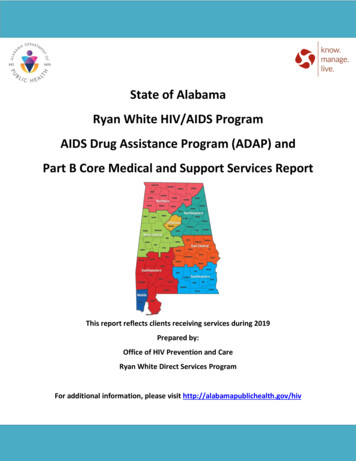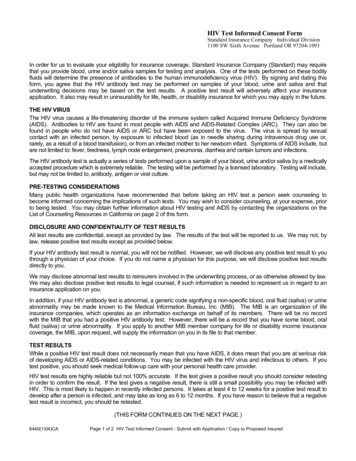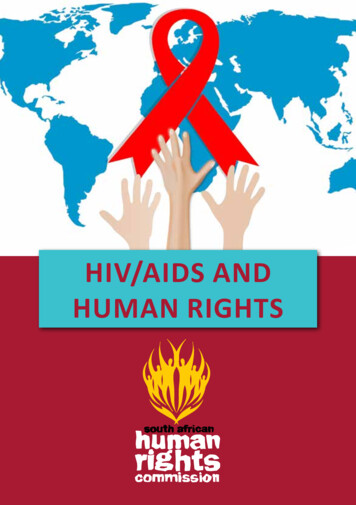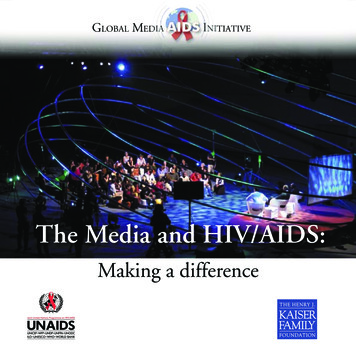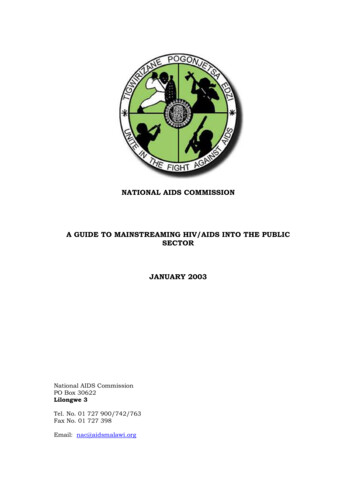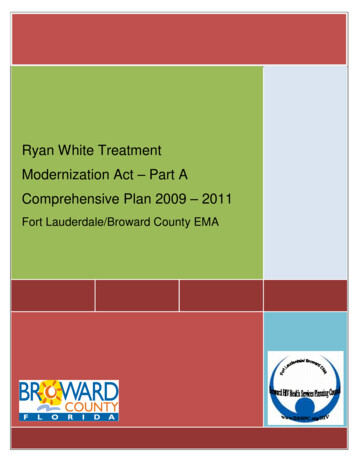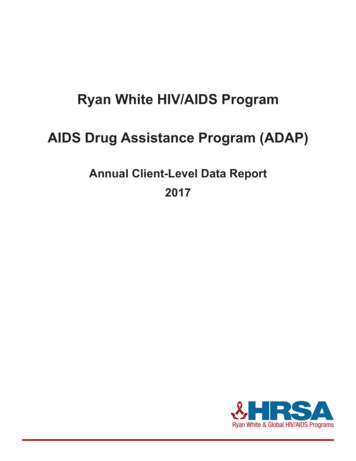
Transcription
Ryan White HIV/AIDS ProgramAIDS Drug Assistance Program (ADAP)Annual Client-Level Data Report2017
The Ryan White HIV/AIDS Program AIDS Drug Assistance Program (ADAP) Annual Client-Level DataReport is published by the Division of Policy and Data, HIV/AIDS Bureau (HAB), Health Resources andServices Administration (HRSA), U.S. Department of Health and Human Services, Rockville, Maryland.Data are presented for clients reported to the HRSA HAB AIDS Drug Assistance Program Data Report(ADR) data system for calendar years 2014 through 2017.The AIDS Drug Assistance Program (ADAP) Annual Client-Level Data Report is not copyrighted andmay be used and copied without permission. Citation of the source is, however, appreciated.Suggested CitationHealth Resources and Services Administration. Ryan White HIV/AIDS Program AIDS Drug AssistanceProgram (ADAP) Annual Client-Level Data Report 2017. hab.hrsa.gov/data/data-reports. PublishedSeptember 2019.Health Resources and Services AdministrationThomas Engels. Acting AdministratorHIV/AIDS Bureau, Health Resources and Services AdministrationLaura W. Cheever, MD, ScM. Associate AdministratorHeather Hauck, MSW, LICSW.Deputy Associate AdministratorAntigone Dempsey, MEd. Director, Division of Policy and DataTracy Matthews, MHA, RN. CAPT, USPHS; Deputy Director, Division of Policy and DataSusan Robilotto, DO. Director, Division of State HIV/AIDS ProgramsRene Sterling, PhD, MHA.Deputy Director, Division of State HIV/AIDS ProgramsGlenn Clark, MSW. ADAP Senior Advisor, Division of State HIV/AIDS ProgramsInformation about the Ryan White HIV/AIDS Program (RWHAP): hab.hrsa.govInformation about the RWHAP AIDS Drug Assistance Program: b-aids-drug-assistance-programEducational and technical assistance materials about HIV infection and the Ryan White HIV/AIDS Program: targetHIV.orgAcknowledgmentsPublication of this report was made possible by the contributions of the Ryan White HIV/AIDS ProgramADAP grant recipients that provided ADAP data to HRSA.ADR Annual Client-Level Data Reportii
ContentsCommentary1Technical Notes5References8Tables91AIDS Drug Assistance Program clients (non-RSR), by year and selectedcharacteristics and services received, 2014–2017—United States and 3 territories. 92AIDS Drug Assistance Program clients (non-RSR), by race/ethnicity and selectedcharacteristics, 2017—United States and 3 territories. 103AIDS Drug Assistance Program clients (non-RSR), by gender and selectedcharacteristics, 2017—United States and 3 territories.114AIDS Drug Assistance Program clients (non-RSR), by federal poverty level andselected characteristics, 2017—United States and 3 territories. 125AIDS Drug Assistance Program clients (non-RSR), by health care coverage andselected characteristics, 2017—United States and 3 territories. 136AIDS Drug Assistance Program clients (non-RSR), by HHS region and selectedcharacteristics, 2017—United States and 3 territories. 147AIDS Drug Assistance Program clients (non-RSR), by service received and selectedcharacteristics, 2017—United States and 3 territories. 158AIDS Drug Assistance Program clients (non-RSR), by year and state, 2014–2017—United States and 3 territories. 169AIDS Drug Assistance Program clients (non-RSR), by age group and state, 2017—United States and 3 territories. 1710 AIDS Drug Assistance Program clients (non-RSR), by race/ethnicity and state, 2017—United States and 3 territories. 1911AIDS Drug Assistance Program clients (non-RSR), by gender and state, 2017—United States and 3 territories. 2112 AIDS Drug Assistance Program clients (non-RSR), by federal poverty level and state,2017—United States and 3 territories. 2313 AIDS Drug Assistance Program clients (non-RSR), by service received and state,2017—United States and 3 territories. 24ADR Annual Client-Level Data Reportiii
COMMENTARYThe Ryan White HIV/AIDS Program (RWHAP), first enacted by U.S. Congress in 1990, provides acomprehensive system of direct HIV healthcare, essential support services, and medications for morethan half a million people with HIV in the United States. The RWHAP has five statutorily defined Partsthat provide funding for medical and support services, technical assistance, clinical training, and thedevelopment of innovative models of care to meet the needs of different communities and populationsaffected by HIV. The RWHAP provides grant funding to all 50 states, the District of Columbia, PuertoRico, the U.S. Virgin Islands, and six U.S. Pacific jurisdictions to support HIV care and treatmentservices. The RWHAP legislation authorizes a portion of Part B funds to be designated for the AIDSDrug Assistance Program (ADAP), which provides U.S. Food and Drug Administration (FDA)-approvedmedications to low-income people with HIV who have limited or no health care coverage.ADAP funds may be used to provide HIV and HIV-related prescription drugs and/or to purchasehealth care coverage for eligible clients and for services that enhance access to, adherence to, andmonitoring of drug treatments. The ADAP is critical to ensuring that people with HIV are able to adhereto medication regimens and remain virally suppressed. People with HIV who achieve and maintainan undetectable viral load have effectively no risk of sexually transmitting the virus to an HIV-negativepartner. The medication and health care coverage assistance offered by ADAP is crucial for attainingoptimal HIV health outcomes among people with HIV, for preventing further transmission of the virusand, ultimately, for ending the HIV epidemic.History of HRSA’s RWHAP AIDS Drug Assistance ProgramThe RWHAP is administered by the U.S. Department of Health and Human Services (HHS), HealthResources and Services Administration (HRSA), HIV/AIDS Bureau (HAB). The RWHAP legislationwas first enacted in 1990 when Congress passed the Ryan White Comprehensive AIDS ResourcesEmergency (CARE) Act to address the crisis of the HIV epidemic in the United States. This legislationhas been amended and reauthorized four times: in 1996, 2000, 2006, and most recently in 2009, as theRyan White HIV/AIDS Treatment Extension Act of 2009.In 1987, the FDA approved the drug azidothymidine (AZT, zidovudine, Retrovir) to treat HIV inthe United States [1]. At that time, the cost of this drug was about 10,000 per year, per person—preventing access for most people with HIV [2]. In 1991, HRSA launched the AZT Drug ReimbursementProgram with 30 million approved by Congress under a public health emergency provision allowinglow-income people with HIV access to HIV treatment [2]. HRSA’s AZT Drug Reimbursement Programlaid the foundation for ADAP, authorized under the CARE Act in 1996 as a separate line item under TitleII (Part B) and classified as a core medical service.Each state/territory operates an ADAP, and each is unique because of the state’s HIV prevalence,health care system, and administrative structures used to ensure HIV medications are available toeligible RWHAP clients [2]. The purpose of ADAP, as stated in the RWHAP legislation, is “to providetherapeutics to treat HIV or prevent the serious deterioration of health arising from HIV in eligibleindividuals, including measures for the prevention and treatment of opportunistic infections” [3]. Tobe eligible to receive assistance from a state/territory under ADAP, the client must have a medicaldiagnosis of HIV and have a low income, as determined by the state/territory.Since Congress first appropriated funds for ADAP in 1996, ADAPs have expanded considerably, ashas the availability of antiretroviral medication. Between 1996 and its reauthorization in 2000, ADAPprogram funding increased from 52 million to 528 million. In addition, for the first time in 2000, ADAPswere permitted to pay health care coverage costs to support coverage of HIV-related medications [2,4].ADR Annual Client-Level Data Report1
In 2006, funding rose another 50%, in a continued effort to reach underserved populations. During the2009 reauthorization of ADAP, funding levels reached 835 million for fiscal year 2010 [1–4].In recent years, ADAP funding has leveled. Full-year appropriations for the RWHAP in fiscal year 2017were 2.3 billion, with 900.3 million (39%) allocated for ADAP. The significant increases in ADAPfunding since the program was first appropriated underscore the important role of ADAP services forpeople with HIV, as evidenced by the following: increased and improved HIV testing, resulting in more people knowing their HIV status increased number of people on ART after the U.S. Public Health Services’ guidelines indicatingthe need for early treatment of people with HIV more people living longer with HIV more intensive use of HIV drugs for long-term survivors increased cost-sharing associated with health insurance increased cost of medications and health care coverage; and prevention of new infections through treatment of HIV.As is true for the entire RWHAP, ADAPs serve as the payor of last resort. ADAP grant recipients andsubrecipients are expected to enroll clients into health care coverage for which the client may beeligible (i.e., Medicare, Medicaid, or other public and private plans). ADAPs coordinate with otherpayors and programs to provide clients with access to HIV medications [2,4].Inaugural ADAP Client-Level Data ReportThis report is the first publication of national ADAP client-level data submitted through the ADAP DataReport (ADR) data system. The ADR was implemented in 2013 and includes annual, client-level datacollected by the ADAP in each state/territory. ADR data describe the demographic characteristics ofclients accessing ADAP services and the ADAP-funded services used. HRSA can use these data toevaluate the reach and impact of ADAP on a national level.The ADR data do not include information about clients receiving non-ADAP RWHAP services, such ascore medical and support services. However, many ADAP clients also receive these services. Together,ADAP services and RWHAP direct care and support services create a comprehensive system of careand treatment for people with HIV. Data for clients receiving non-ADAP RWHAP services are reportedto HRSA through the RWHAP Services Report (RSR) and are published annually in the RWHAP AnnualClient-Level Data Report [5].This document includes data reported to HRSA for all clients receiving ADAP services during calendaryears 2014 through 2017. The data presented include client demographics, socioeconomic factors(e.g., income as a percentage of the federal poverty level [FPL], health care coverage), and serviceutilization. Although ADR data reporting began in 2013, this report includes data beginning in 2014 toensure the data quality.Highlights of the AnalysesThe data presented in this report should be interpreted with caution. Each ADAP operates within thebroader context of the state’s health care system and public health infrastructure.RWHAP AIDS Drug Assistance Program ClientsEach year, ADAPs serve approximately 260,000 or more people with HIV. The number of peoplereceiving ADAP services has been largely consistent from 2014 through 2017. In 2017, 268,174ADR Annual Client-Level Data Report2
clients received ADAP services (Table 1). Although the national number of ADAP clients has remainedconsistent, variability occurred by state (Table 8); these shifts may be attributed to a variety of reasons,including changes to data collection, the state’s health care landscape, eligibility requirements, andother factors during these years.The majority of ADAP clients are male. In 2017, 77.7% of clients were male, 21.1% were female,and 1.2% were transgender (Table 1). The gender distribution of ADAP clients has remained largelyconsistent since 2014. See Technical Notes for information about gender designation.Nearly three-quarters of ADAP clients are from racial/ethnic minority populations. In 2017, 39.5%of clients self-identified as Black/African American, 26.4% as Hispanic/Latino, and less than 2% each asAsian, American Indian/Alaska Native, Native Hawaiian/Pacific Islander, and persons of multiple races.Less than one-third (30.9%) of ADAP clients self-identified as White. These race/ethnicity distributionshave remained consistent since 2014 (Table 1).ADAP clients from racial/ethnic minority populations are younger than White clients. In 2017,56.9% of White ADAP clients were aged 50 years or older, compared with 44.2% Native Hawaiians/Pacific Islanders, 41.6% American Indians/Alaska Natives, 38.2% Blacks/African Americans, 35.3% ofclients of multiple races, 34.9% of Hispanics/Latinos, and 29.8% of Asians (Table 2).More than half of female ADAP clients are Black/African American. In 2017, among the femaleclients whose race/ethnicity was reported, 56.5% were Black/African American, 23.1% were Hispanic/Latina, 17.7% were White, and less than 2% each were Asian, American Indian/Alaska Native, NativeHawaiian/Pacific Islander, or multiple races (Table 3). In comparison, 34.8% of male clients were Black/African American, 34.7% were White, and 27.2% were Hispanic/Latino.Socioeconomic Factors Among ADAP ClientsMore than one-third of all ADAP clients have no health care coverage. In 2017, 38.6% of ADAPclients had no health care coverage, a decrease from 44.4% in 2014. (Table 1). This percentage variedby race, with 51.2% of Hispanics/Latinos and 43.6% of Blacks/African Americans with no coveragecompared with 22.2% of White clients (Table 2). This percentage also varied by gender. The percentageswith no health care coverage was 38.4% among males and 39.0% among females. The lack of coveragewas 50.6% among transgender women and 31.7% among transgender men. (Table 3).Higher percentages of ADAP clients from racial/ethnic minority populations are living at orbelow 100% FPL compared with White ADAP clients. In 2017, among race/ethnicity groups,Hispanics/Latinos had the highest percentage of clients at or below 100% FPL (51.8%), followed byAmerican Indians/Alaska Natives (49.5%), Blacks/African Americans (48.3%), clients of multiple races(45.8%), Native Hawaiians/Pacific Islanders (40.5%), Asians (35.7%), and Whites (33.7%) (Table 2).Higher percentages of female and transgender ADAP clients are living at or below 100% FPLcompared with male clients. In 2017, among female clients, 52.7% were living at or below 100% FPL,compared with 42.0% of male clients. Among transgender women, transgender men, and clients of othertransgender identities, 63.7%, 44.3%, and 58.0%, respectively, were living at or below 100% FPL. (Table 3).Service UtilizationThe number of clients receiving only full-pay medication support has decreased, whereas anincreased number of clients are receiving other services or a combination of services. AmongADAP clients with service utilization information in 2017, 48.4% received full-pay medication supportonly, a decrease from 64.1% in 2014. Concurrently, 20.4% of ADAP clients in 2017 received medicationco-pay/deductible assistance from ADAPs compared with 12.3% in 2014. The percentage of clientsADR Annual Client-Level Data Report3
receiving multiple services also increased from 17.1% in 2014 to 26.1% in 2017 (Table 1). Thesechanges may be attributed to changes in the health care landscape during this timeframe.The use of full-pay medication services is higher among clients younger than age 50 years, andthe number of medication co-pay/deductible services is higher among clients aged 50 years andolder. In 2017, 69.9% of clients accessing full-pay medication services were younger than age 50.In comparison, among clients accessing medication co-pay/deductible services, 65.7% were aged50 years and older. Clients receiving health care coverage premium assistance or receiving multipleservices were distributed evenly between clients older and younger than 50 years of age (Table 7).For each service type, distribution differs by HHS Region. In 2017, among clients receivingmedication co-pay/deductible, the highest percentage were in Region 9 (27.7%; Arizona, California,Guam, Hawaii, and Nevada). Among ADAP clients receiving full-pay medication only, the highestpercentage was in Region 4 (37.3%; Alabama, Florida, Georgia, Kentucky, Mississippi, North Carolina,South Carolina, and Tennessee). Region 4 also had the highest percentage (22.8%) of ADAP clientsreceiving multiple services compared with other regions. Among clients receiving insurance premiumassistance, the highest percentage (23.3%) was in Region 2 (New Jersey, New York, Puerto Rico, andU.S. Virgin Islands) (Table 7).ADR Annual Client-Level Data Report4
TECHNICAL NOTESThe AIDS Drug Assistance Program (ADAP) Data Report (ADR) is the U.S. Department of Health andHuman Services (HHS), Health Resources and Services Administration (HRSA), HIV/AIDS Bureau’s(HAB) primary source of annual, client-level data to evaluate the impact of the ADAP program on anational level. The ADR allows HAB to characterize the individuals using the program, describe theADAP-funded services being used, and delineate costs associated with these services [6].The ADR was developed and implemented in 2013. To allow sufficient time for data quality assessment,ADR data included in this report begin with 2014. All Part B ADAP recipients are required to submit datato the ADR as a condition of the RWHAP Part B grant award. The ADR consists of two components:(1) the Recipient Report and (2) the Client Report. The Recipient Report is a collection of informationabout ADAP administration, funding, and policies. The Client Report (or client-level data) is a collectionof records that includes each ADAP client’s encrypted unique identifier (“eUCI”), basic demographic data,enrollment and certification information, and client-level data for clients enrolled during the calendar yearreporting period (January 1 to December 31) [6].ADR data do not include information on non-ADAP RWHAP services, such as outpatient ambulatoryhealth services, case management, or other services provided by RWHAP. Although the ADR may includeRWHAP clients who received additional services, the ADR does not collect information to identify whichclients overlap with other RWHAP services. Client-level data from these services are reported throughanother data system [5] and are published annually in the RWHAP Annual Client-Level Data Report.Presentation of DataThe data in this report include information received by HRSA HAB for clients served by ADAPduring calendar years 2014–2017. The purpose of the client demographics is to describe thesociodemographic characteristics of all clients enrolled in the ADAP, regardless of whether theyreceived services (i.e., a client can be enrolled in ADAP but not use the service) [6]. Tables 1–7: National-level data—Numbers and percentages of clients served by ADAP (nonRSR), presented by year, selected demographic stratifications, HHS region, and servicesreceived. Tables 8‒13: State-level data—Numbers and percentages of clients served by the ADAP (nonRSR) by state, presented by selected demographic stratificationsTables 1‒8 display subtotals for each subpopulation and the overall totals. The subtotals are displayedto reflect the denominator used for the percentage calculation of each subpopulation. Because ofmissing data, the values in each column may not sum to the column total.ADAP ClientsTo be eligible for enrollment in ADAP services, an ADAP client must have a diagnosis of HIV and a lowincome as defined by the state of residence. An ADAP client is any person who is certified as eligibleto receive ADAP services, regardless of whether the person used ADAP services during the reportingperiod. During the reporting period, an ADAP client may have received medication assistance and/or health insurance assistance, been disenrolled, and/or been deemed eligible but did not receive anyservices. In the event of a funding shortage, clients may be placed on a waiting list (there are currentlyno ADAP waiting lists) [6].ADR Annual Client-Level Data Report5
Age GroupADAP recipients are required to report the client’s year of birth. This information is used to calculatethe client’s age during the designated year as a discrete variable. For tables displaying age groups(Tables 1–7), client ages were categorized to align with the Centers for Disease Control andPrevention’s (CDC) National HIV Surveillance System (NHSS) age group delineations. The age groupdelineations are as follow: 13, 13–14, 15–19, 20–24, 25–29, 30–34, 35–39, 40–44, 45–49, 50–54,55–59, 60–64, and 65 years. In Table 9, client ages were categorized using broader age groupdelineations: 13, 13‒24, 25‒34, 35‒44, 45‒54, 55‒64, and 65 years.Race/EthnicityRecipients report race/ethnicity information for ADAP clients according to the Office of Management andBudget (OMB) reporting standards. The OMB standards have five categories for race: American Indian orAlaska Native, Asian, Black or African American, Native Hawaiian or Other Pacific Islander, and White. Dataon ethnicity have two categories: (1) Hispanic or Latino, and (2) not Hispanic or Latino. Race and ethnicityare submitted as separate variables and combined for analysis. The race/ethnicity variable is categorized asAmerican Indian or Alaska Native, Asian, Black or African American, Hispanic or Latino, Native Hawaiian orother Pacific Islander, White, and “multiple races” (two or more categories of race reported).In this report, clients categorized by race were not Hispanic or Latino; however, the number of clientsreported in each race category may include clients whose ethnicity was not reported. ADAP recipientsare expected to make every effort to obtain and report race and ethnicity, based on each client’s selfreport. Self-identification is the preferred means of obtaining this information.GenderGender-related data are based on client self-report. Gender designations in this report are male,female, or transgender. Transgender is an umbrella term used to identify people whose sex assigned atbirth does not match their current gender identity or expression. Transgender clients are subsequentlyreported as transgender male to female (MTF), transgender female to male (FTM), or transgenderunknown; the transgender unknown category may include transgender people who do not identify withthese transgender variable options.Federal Poverty LevelPoverty level characterizes the client’s annual household income as a percentage of the FPL at theend of the reporting period. The poverty levels were categorized as 0–100% FPL, 101–138% FPL,139–250% FPL, 251–400% FPL, and 400% FPL.Health Care CoverageADAP recipients are required to report all sources of health care coverage that each client had forany part of the reporting period, regardless of whether the ADAP paid for it. Health care coveragewas categorized as private employer, private individual, Medicare, Medicaid, Medicare and Medicaid(dual eligibility), Veterans Administration, Indian Health Service, other plan, multiple coverages, and nocoverage. The Medicaid classification also includes the Children’s Health Insurance Program (CHIP) andother public state health care coverage programs. The Medicare Part D classification is a stand-aloneprescription drug coverage insurance and includes co-insurance, co-payment, or donut hole coverage.ADAP ServicesADAP services include both medication assistance services and health care coverage premium andcost-sharing assistance services, which are provided to eligible clients enrolled in ADAP. All ADAPfunds, regardless of their source (e.g., state funds, RWHAP Part B ADAP Base, RWHAP Part B Base,ADR Annual Client-Level Data Report6
RWHAP Part B Supplemental Funding, ADAP Emergency Relief Funds, RWHAP Part A contributions,340B rebates, ADAP Crisis Task Force Rebates), are reported in the ADR [6].Medication assistance (i.e., full-pay medication support) is the use of ADAP funds to purchase FDAapproved medications for the treatment of HIV and the prevention and treatment of other opportunisticinfections commonly associated with HIV/AIDS. In addition, other types of medications can bepurchased by ADAP recipients using ADAP funding if those medications support a client’s retention incare (e.g., medication to treat hepatitis C).Health care coverage assistance is the use of ADAP funds to pay for one or more of the following: Full premium payment Partial premium payment Medication co-pay/deductible (including Medicare Part D coinsurance, co-payment, or donut holecoverage)A full premium payment is when the ADAP pays 100% of the client’s health insurance premium. Apartial payment is when the ADAP pays a portion of the health insurance premium (i.e., 100%).A medication co-pay/deductible (including Medicare Part D-related costs) is when the ADAP paysthe co-pay/deductible for the client’s HIV-related medication. Medication co-pays, deductibles, andcoinsurance are considered health care coverage assistance services, not medication services [6].RegionThe U.S. Department of Health and Human Services (HHS) uses 10 geographic designations forclassifying regions of the United States that encompass all states and territories. The classification ofstates and territories within these regions is as follows: Region 1: Connecticut, Maine, Massachusetts, New Hampshire, Rhode Island, Vermont Region 2: New Jersey, New York, Puerto Rico, U.S. Virgin Islands Region 3: Delaware, District of Columbia, Maryland, Pennsylvania, Virginia, West Virginia Region 4: Alabama, Florida, Georgia, Kentucky, Mississippi, North Carolina, South Carolina, Tennessee Region 5: Illinois, Indiana, Michigan, Minnesota, Ohio, Wisconsin Region 6: Arkansas, Louisiana, New Mexico, Oklahoma, Texas Region 7: Iowa, Kansas, Missouri, Nebraska Region 8: Colorado, Montana, North Dakota, South Dakota, Utah, Wyoming Region 9: Arizona, California, Guam, Hawaii, Nevada Region 10: Alaska, Idaho, Oregon, WashingtonThe six U.S. Pacific jurisdictions are included in HHS Region 9; however, only Guam submits clientlevel data. The other jurisdictions, therefore, are not included in this report. Puerto Rico and the U.S.Virgin Islands are included in Region 2.StateState data are displayed in Tables 8‒13. State-level analyses include data submitted for all RWHAPADAP services. Clients receiving services in multiple states are not included in state-specific totals;these clients make up less than 2% of the total RWHAP population. In addition, data presented by stateinclude data for all clients served by State ADAPs and are not separated by the type of ADAP-specificfunding (i.e., RWHAP Part B, RWHAP Part B Supplemental, and ADAP Emergency Relief Funds).ADR Annual Client-Level Data Report7
REFERENCES1. Health Resources and Services Administration (HRSA). 2019. Ryan White & Global HIV/AIDSProgram–A Living History. hab.hrsa.gov/livinghistory/index.htm. Accessed May 17, 2019.2. HRSA. Ryan White HIV/AIDS Program AIDS Drug Assistance Program (ADAP) Manual 2016.January 2016. Available at gram-adap-manual.3. U.S. Public Health Service. December 18, 2015; Amended January 28, 2016. The Ryan White HIV/AIDS Treatment Extension Act of 2009. “Title XXVI of the Public Health Service Act.” Available nts-management/legislationtitlexxvi.pdf.4. NASTAD. 2018. 2018 Annual Report: National Ryan White HIV/AIDS Program Part B & ADAPMonitoring Project Annual Report. ual-report.pdf.5. HRSA. 2018. Ryan White HIV/AIDS Program Annual Client-Level Data Report 2017. Available athab.hrsa.gov/data/data-reports.6. HRSA. 2019. AIDS Drug Assistance Program Data Report (ADR) Instruction Manual 2018.Available at DR Annual Client-Level Data Report8
TABLESTable 1. AIDS Drug Assistance Program clients (non-RSR), by year and selected characteristics and services received, 2014–2017—United States and 3 territoriesNo.2014%No.2015%No.2016%No.2017%Age group (yr) 445–4950–5455–5960–64 ,43144,39929,68617,04712,654268,6360.1 217,82214,574259,5280.1 919,65616,877266,1460.1 3521,11019,321268,1
Services Administration (HRSA), U.S. Department of Health and Human Services, Rockville, Maryland. Data are presented for clients reported to the HRSA HAB . AIDS Drug Assistance Program Data Report (ADR) data system for calendar years 2014 through 2017. . 8 AIDS Drug Assistance Program clients (non-RSR), by year and state, 2014-2017— .
